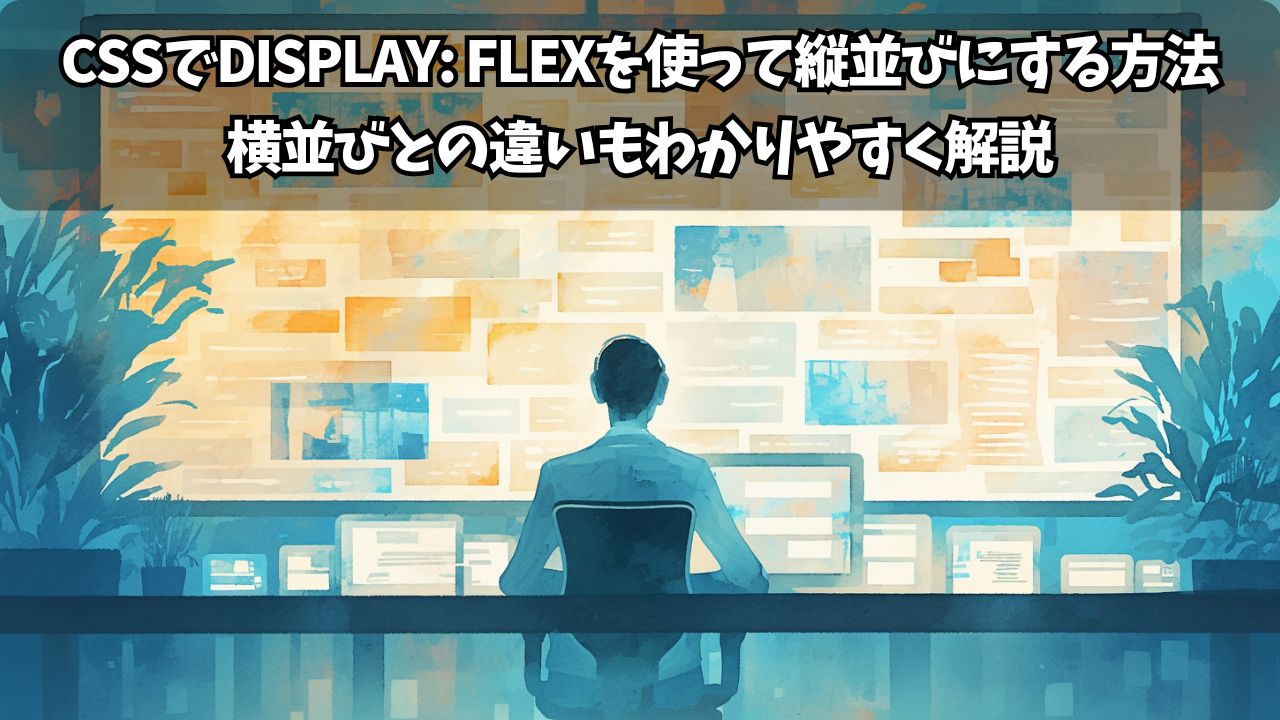「flexbox」といえば、横に並べるために使うものと思っていませんか?
実はdisplay: flexは、ちょっと設定を変えるだけで縦並び(縦方向のレイアウト)にも簡単にできます。
これをうまく使うと、スマホの画面で自然に縦に並べたり、フォームやボタンを上下にスッキリ配置できます。
この記事では、CSSのdisplay: flexを使って要素を縦並びにする基本の方法や注意点、横並びとの違いをわかりやすく紹介します。「え、こんなに簡単だったの?」と驚くこと間違いなしです!
そもそもflexのデフォルトは「横並び」

flexboxの基本動作
display: flexを指定すると、デフォルトではflex-direction: rowが適用されます。つまり、子要素は横方向(左から右)に並びます。
基本のコード例
.container {
display: flex;
}
<div class="container">
<div class="item">アイテム1</div>
<div class="item">アイテム2</div>
<div class="item">アイテム3</div>
</div>
結果:アイテム1、アイテム2、アイテム3が横に一列に並ぶ
横並びがよく使われる場面
ナビゲーションメニュー
.nav {
display: flex;
}
.nav-item {
padding: 10px 20px;
}
用途:ヘッダーのメニュー項目を横に配置
カードレイアウト
.card-container {
display: flex;
gap: 20px;
}
.card {
flex: 1;
padding: 20px;
border: 1px solid #ddd;
}
用途:商品カードやブログ記事を横に並べる
ボタングループ
.button-group {
display: flex;
}
.button {
margin-right: 10px;
}
用途:「保存」「キャンセル」などのボタンを横に配置
なぜ横並びがデフォルト?
歴史的背景
- HTML の自然な流れ:左から右に読む文化圏に合わせて
- インライン要素の延長:
<span>や<a>の並び方を踏襲 - 使用頻度:ナビゲーションやボタン配置で横並びの需要が高い
display: flexで縦並びにするには?
flex-direction: columnの魔法
flex-direction: column;を指定すると、子要素が縦(上から下)に並びます。
基本の縦並びコード
.container {
display: flex;
flex-direction: column;
}
<div class="container">
<div class="item">アイテム1</div>
<div class="item">アイテム2</div>
<div class="item">アイテム3</div>
</div>
結果:アイテム1、アイテム2、アイテム3が縦に一列に並ぶ
flex-directionの全オプション
| 値 | 方向 | 説明 |
|---|---|---|
row | 横(左→右) | デフォルト、水平方向 |
row-reverse | 横(右→左) | 水平方向で順序反転 |
column | 縦(上→下) | 垂直方向 |
column-reverse | 縦(下→上) | 垂直方向で順序反転 |
各方向の実例
row-reverse(右から左へ)
.container {
display: flex;
flex-direction: row-reverse;
}
結果:アイテム3、アイテム2、アイテム1の順で横並び
column-reverse(下から上へ)
.container {
display: flex;
flex-direction: column-reverse;
}
結果:アイテム3、アイテム2、アイテム1の順で縦並び
縦並びの実用例
スマホ向けメニュー
.mobile-menu {
display: flex;
flex-direction: column;
width: 100%;
}
.menu-item {
padding: 15px;
border-bottom: 1px solid #eee;
text-align: center;
}
メリット:スマホの狭い画面で各項目がタップしやすくなる
入力フォーム
.form {
display: flex;
flex-direction: column;
max-width: 400px;
}
.form-group {
margin-bottom: 20px;
}
.form-group label {
margin-bottom: 5px;
}
.form-group input {
padding: 10px;
border: 1px solid #ccc;
}
メリット:ラベルと入力欄が縦に整列して見やすい
サイドバーのウィジェット
.sidebar {
display: flex;
flex-direction: column;
gap: 30px;
}
.widget {
background: #f9f9f9;
padding: 20px;
border-radius: 8px;
}
メリット:複数のウィジェットが自然に縦積みされる
レスポンシブでの切り替え
PCでは横、スマホでは縦
.container {
display: flex;
flex-direction: row; /* PC: 横並び */
}
@media (max-width: 768px) {
.container {
flex-direction: column; /* スマホ: 縦並び */
}
}
効果:画面サイズに応じて最適なレイアウトに自動変更
縦並び+中央揃えにする方法

flexboxの軸を理解しよう
縦並び(flex-direction: column)の場合の軸は以下のようになります:
- 主軸(Main Axis):縦方向(上から下)
- 交差軸(Cross Axis):横方向(左から右)
横方向に中央寄せ:align-items
align-itemsを使うと、交差軸(横方向)に中央寄せできます。
基本コード
.container {
display: flex;
flex-direction: column;
align-items: center;
}
実用例:カードを横中央に配置
.card-container {
display: flex;
flex-direction: column;
align-items: center;
gap: 20px;
}
.card {
width: 300px;
padding: 20px;
background: #fff;
border: 1px solid #ddd;
border-radius: 8px;
box-shadow: 0 2px 4px rgba(0,0,0,0.1);
}
結果:複数のカードが縦に並び、それぞれが横方向の中央に配置
align-itemsの全オプション
| 値 | 効果 | 使用場面 |
|---|---|---|
stretch | 交差軸いっぱいに伸ばす | デフォルト |
flex-start | 交差軸の開始位置 | 左寄せ |
flex-end | 交差軸の終了位置 | 右寄せ |
center | 交差軸の中央 | 中央寄せ |
baseline | ベースライン揃え | テキスト揃え |
縦方向(主軸)に中央寄せ:justify-content
親要素の高さを決めて、justify-contentを使うと縦方向の配置を制御できます。
基本コード
.container {
display: flex;
flex-direction: column;
justify-content: center;
height: 400px; /* 高さが必要 */
}
実用例:ページ全体を中央配置
.full-height-container {
display: flex;
flex-direction: column;
justify-content: center;
align-items: center;
min-height: 100vh; /* 画面全体の高さ */
}
.content {
text-align: center;
padding: 40px;
background: #f8f9fa;
border-radius: 12px;
}
効果:ログイン画面やランディングページで画面中央に要素配置
justify-contentの全オプション
| 値 | 効果 | 使用場面 |
|---|---|---|
flex-start | 主軸の開始位置 | 上寄せ |
flex-end | 主軸の終了位置 | 下寄せ |
center | 主軸の中央 | 中央寄せ |
space-between | 要素間を等間隔 | 上下端配置 |
space-around | 要素周囲を等間隔 | 均等配置 |
space-evenly | 完全に等間隔 | 完全均等配置 |
完璧な中央配置の実現
上下左右どちらも中央
.perfect-center {
display: flex;
flex-direction: column;
justify-content: center;
align-items: center;
min-height: 100vh;
}
実用例:モーダルダイアログ
.modal-overlay {
position: fixed;
top: 0;
left: 0;
width: 100%;
height: 100%;
background: rgba(0, 0, 0, 0.5);
display: flex;
flex-direction: column;
justify-content: center;
align-items: center;
}
.modal {
background: white;
padding: 30px;
border-radius: 12px;
max-width: 500px;
width: 90%;
}
space系の活用例
ヘッダーとフッターを上下端に配置
.page-layout {
display: flex;
flex-direction: column;
min-height: 100vh;
justify-content: space-between;
}
.header {
background: #333;
color: white;
padding: 20px;
}
.main {
flex: 1; /* 残りスペースを占有 */
padding: 20px;
}
.footer {
background: #f8f9fa;
padding: 20px;
text-align: center;
}
効果:ヘッダーが上、メインコンテンツが中央、フッターが下に固定
横並びと縦並びの違いを整理

flex-directionによる軸の変化
横並び(row)の場合
.horizontal {
display: flex;
flex-direction: row;
}
- 主軸:横方向(左→右)
- 交差軸:縦方向(上→下)
- justify-content:左右方向の配置制御
- align-items:上下方向の配置制御
縦並び(column)の場合
.vertical {
display: flex;
flex-direction: column;
}
- 主軸:縦方向(上→下)
- 交差軸:横方向(左→右)
- justify-content:上下方向の配置制御
- align-items:左右方向の配置制御
実際の比較例
同じCSSプロパティでも結果が変わる
横並びでの中央寄せ
.horizontal-center {
display: flex;
flex-direction: row;
justify-content: center; /* 左右中央 */
align-items: center; /* 上下中央 */
height: 200px;
}
縦並びでの中央寄せ
.vertical-center {
display: flex;
flex-direction: column;
justify-content: center; /* 上下中央 */
align-items: center; /* 左右中央 */
height: 200px;
}
プロパティ効果の対比表
| プロパティ | 横並び(row) | 縦並び(column) |
|---|---|---|
justify-content: center | 左右中央 | 上下中央 |
justify-content: space-between | 左右端に配置 | 上下端に配置 |
align-items: center | 上下中央 | 左右中央 |
align-items: flex-start | 上寄せ | 左寄せ |
align-items: flex-end | 下寄せ | 右寄せ |
よくある間違いと対処法
間違い例1:軸を混同
/* 縦並びで左右中央にしたいのに... */
.wrong {
display: flex;
flex-direction: column;
justify-content: center; /* これは上下中央 */
}
/* 正解 */
.correct {
display: flex;
flex-direction: column;
align-items: center; /* 左右中央はこちら */
}
間違い例2:高さ指定を忘れる
/* justify-contentが効かない */
.wrong {
display: flex;
flex-direction: column;
justify-content: center;
/* 高さ指定がないと効果なし */
}
/* 正解 */
.correct {
display: flex;
flex-direction: column;
justify-content: center;
min-height: 300px; /* 高さ指定が必要 */
}
使い分けの指針
横並びを選ぶべき場面
- ナビゲーションメニュー
- ボタングループ
- カード一覧(PC表示)
- タブメニュー
- ツールバー
縦並びを選ぶべき場面
- フォーム要素
- モバイルメニュー
- サイドバーウィジェット
- 縦長リスト
- ステップ表示
レスポンシブでの切り替え戦略
.responsive-container {
display: flex;
}
/* デスクトップ:横並び */
@media (min-width: 769px) {
.responsive-container {
flex-direction: row;
}
}
/* タブレット・スマホ:縦並び */
@media (max-width: 768px) {
.responsive-container {
flex-direction: column;
}
}
実践的な活用例とテクニック
よくあるレイアウトパターン
パターン1:フォームレイアウト
.form-container {
display: flex;
flex-direction: column;
max-width: 400px;
margin: 0 auto;
gap: 20px;
}
.form-group {
display: flex;
flex-direction: column;
gap: 5px;
}
.form-group label {
font-weight: bold;
color: #333;
}
.form-group input,
.form-group textarea {
padding: 12px;
border: 1px solid #ddd;
border-radius: 4px;
font-size: 16px;
}
.form-group input:focus,
.form-group textarea:focus {
outline: none;
border-color: #007bff;
box-shadow: 0 0 0 2px rgba(0,123,255,0.25);
}
HTML例
<form class="form-container">
<div class="form-group">
<label for="name">お名前</label>
<input type="text" id="name" name="name">
</div>
<div class="form-group">
<label for="email">メールアドレス</label>
<input type="email" id="email" name="email">
</div>
<div class="form-group">
<label for="message">メッセージ</label>
<textarea id="message" name="message" rows="5"></textarea>
</div>
<button type="submit">送信</button>
</form>
パターン2:カードのスタック表示
.card-stack {
display: flex;
flex-direction: column;
gap: 24px;
max-width: 600px;
margin: 0 auto;
}
.card {
background: white;
border-radius: 12px;
padding: 24px;
box-shadow: 0 4px 6px rgba(0, 0, 0, 0.1);
transition: transform 0.2s ease, box-shadow 0.2s ease;
}
.card:hover {
transform: translateY(-4px);
box-shadow: 0 8px 25px rgba(0, 0, 0, 0.15);
}
.card-header {
display: flex;
flex-direction: column;
gap: 8px;
margin-bottom: 16px;
}
.card-title {
font-size: 1.25rem;
font-weight: bold;
color: #1a1a1a;
}
.card-date {
color: #666;
font-size: 0.875rem;
}
パターン3:ナビゲーションの縦並び
.sidebar-nav {
display: flex;
flex-direction: column;
background: #f8f9fa;
padding: 20px 0;
min-height: 100vh;
width: 250px;
}
.nav-item {
display: flex;
align-items: center;
padding: 12px 20px;
color: #333;
text-decoration: none;
transition: background-color 0.2s ease;
}
.nav-item:hover {
background-color: #e9ecef;
}
.nav-item.active {
background-color: #007bff;
color: white;
}
.nav-icon {
margin-right: 12px;
width: 20px;
height: 20px;
}
高度なテクニック
gapプロパティで間隔調整
.gap-example {
display: flex;
flex-direction: column;
gap: 16px; /* 要素間の統一間隔 */
}
/* 従来のmarginを使う必要がない */
.old-way {
display: flex;
flex-direction: column;
}
.old-way > * {
margin-bottom: 16px; /* 面倒な指定 */
}
.old-way > *:last-child {
margin-bottom: 0; /* 最後の要素は除外 */
}
flex-growで伸縮制御
.stretch-layout {
display: flex;
flex-direction: column;
height: 100vh;
}
.header {
background: #333;
color: white;
padding: 20px;
/* 固定サイズ */
}
.main-content {
flex: 1; /* flex-grow: 1 の省略形 */
padding: 20px;
overflow-y: auto;
/* 残りスペースを占有 */
}
.footer {
background: #f8f9fa;
padding: 10px 20px;
/* 固定サイズ */
}
ネストしたflexコンテナ
.complex-layout {
display: flex;
flex-direction: column;
gap: 20px;
}
.section {
display: flex;
flex-direction: column;
background: #f9f9f9;
padding: 20px;
border-radius: 8px;
}
.section-header {
display: flex;
justify-content: space-between;
align-items: center;
margin-bottom: 16px;
padding-bottom: 16px;
border-bottom: 1px solid #e0e0e0;
}
.section-content {
display: flex;
flex-direction: column;
gap: 12px;
}
レスポンシブ対応のベストプラクティス
モバイルファーストアプローチ
/* モバイル(縦並び)がベース */
.responsive-grid {
display: flex;
flex-direction: column;
gap: 20px;
padding: 16px;
}
/* タブレット:2列表示 */
@media (min-width: 768px) {
.responsive-grid {
flex-direction: row;
flex-wrap: wrap;
padding: 24px;
}
.responsive-grid > * {
flex: 0 0 calc(50% - 10px);
}
}
/* デスクトップ:3列表示 */
@media (min-width: 1024px) {
.responsive-grid {
padding: 32px;
}
.responsive-grid > * {
flex: 0 0 calc(33.333% - 14px);
}
}
コンテナクエリ対応(将来対応)
@container (max-width: 500px) {
.adaptive-layout {
flex-direction: column;
}
}
@container (min-width: 501px) {
.adaptive-layout {
flex-direction: row;
}
}
パフォーマンスとアクセシビリティ
パフォーマンス最適化
.optimized-flex {
display: flex;
flex-direction: column;
/* GPU加速を有効化 */
transform: translateZ(0);
/* スムーズなアニメーション */
transition: transform 0.2s ease;
}
/* will-changeでブラウザに最適化のヒント */
.animating-element {
will-change: transform;
}
アクセシビリティ配慮
.accessible-nav {
display: flex;
flex-direction: column;
}
.accessible-nav a {
padding: 12px 16px;
display: flex;
align-items: center;
min-height: 44px; /* タッチターゲットサイズ */
color: #333;
text-decoration: none;
}
.accessible-nav a:focus {
outline: 2px solid #007bff;
outline-offset: 2px;
}
/* 縦並び順序の視覚的調整 */
.visual-order {
order: 2; /* 視覚順序を変更 */
}
/* スクリーンリーダー用の隠しテキスト */
.sr-only {
position: absolute;
width: 1px;
height: 1px;
padding: 0;
margin: -1px;
overflow: hidden;
clip: rect(0, 0, 0, 0);
white-space: nowrap;
border: 0;
}
まとめ
CSSのdisplay: flexはflex-directionを使い分けるだけで、横並びも縦並びも自由自在にコントロールできるとてもパワフルなレイアウト方法です。
重要ポイントの再確認
基本の使い分け
- 横並び:
flex-direction: row(デフォルト) - 縦並び:
flex-direction: column
中央揃えの方法
- 横方向中央:
align-items: center - 縦方向中央:
justify-content: center(高さ指定必要) - 完璧な中央:両方を組み合わせ
軸の理解
- row:主軸=横、交差軸=縦
- column:主軸=縦、交差軸=横
- justify-content:主軸方向の配置
- align-items:交差軸方向の配置
実用的な活用シーン
縦並びが効果的な場面
- スマホ向けレスポンシブデザイン
- 入力フォームのレイアウト
- ナビゲーションメニュー(サイドバー)
- カードのスタック表示
- ページ全体の構造(ヘッダー、メイン、フッター)
モダンな開発のコツ
gapプロパティで間隔調整flex: 1で伸縮制御- レスポンシブでの方向切り替え
- アクセシビリティへの配慮








コメント